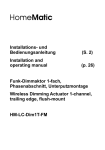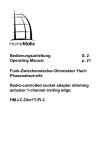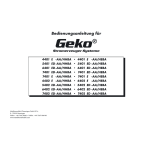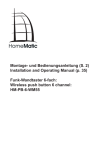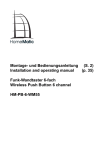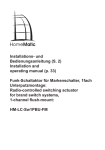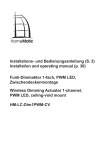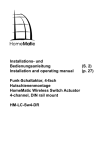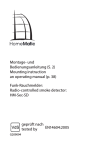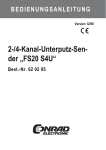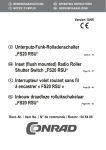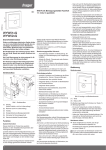Download Installations- und Bedienungsanleitung (S. 2) Installation and - eQ-3
Transcript
Installations- und Bedienungsanleitung (S. 2) Installation and operating manual (p. 26) Funk-Dimmaktor 1fach Phasenabschnitt Unterputzmontage: Radio-controlled dimming actuator 1-channel trailing edge flush-mount: HM-LC-Dim1T-FM Inhaltsverzeichnis 1. Ausgabe Deutsch 02/2012 Dokumentation © 2012 eQ-3 AG, Deutschland Alle Rechte vorbehalten. Ohne schriftliche Zustimmung des Herausgebers darf dieses Handbuch auch nicht auszugsweise in irgendeiner Form reproduziert werden oder unter Verwendung elektronischer, mechanischer oder chemischer Verfahren vervielfältigt oder verarbeitet werden. Es ist möglich, dass das vorliegende Handbuch noch drucktechnische Mängel oder Druckfehler aufweist. Die Angaben in diesem Handbuch werden jedoch regelmäßig überprüft und Korrekturen in der nächsten Ausgabe vorgenommen. Für Fehler technischer oder drucktechnischer Art und ihre Folgen übernehmen wir keine Haftung. Alle Warenzeichen und Schutzrechte werden anerkannt. Printed in Hong Kong Änderungen im Sinne des technischen Fortschritts können ohne Vorankündigung vorgenommen werden. 1 Hinweise zu dieser Anleitung . . . . . . . . . . . . . . 4 2Gefahrenhinweise . . . . . . . . . . . . . . . . . . . . . . . 4 3Funktion . . . . . . . . . . . . . . . . . . . . . . . . . . . . . . 7 4 Allgemeine Systeminformation zu HomeMatic . 9 5 Allgemeine Hinweise zum Funkbetrieb . . . . . . . 9 6Installation . . . . . . . . . . . . . . . . . . . . . . . . . . . . 11 7Inbetriebnahme . . . . . . . . . . . . . . . . . . . . . . . . 15 7.1 Einfache Bedienfunktionen mit angeschlossenem Taster . . . . . . . . . . . . . . . . . 15 7.2Anlernen . . . . . . . . . . . . . . . . . . . . . . . . . . . . . 16 7.3 Bedienfunktionen nach Anlernen . . . . . . . . . . 18 8 Zurücksetzen in den Auslieferungszustand . . . 19 9 Rückmeldungen der Geräte-LED . . . . . . . . . . 20 9.1Blinkcodes . . . . . . . . . . . . . . . . . . . . . . . . . . . . 20 9.2 Anzeige des Betriebszustandes . . . . . . . . . . . 20 10 Verhalten nach Spannungswiederkehr . . . . . . 21 11 Wartung und Reinigung . . . . . . . . . . . . . . . . . . 22 12 Weitere Betriebshinweise . . . . . . . . . . . . . . . . 22 13 Technische Daten . . . . . . . . . . . . . . . . . . . . . . 24 91900 / V 2.1 2 3 1 Hinweise zu dieser Anleitung Lesen Sie diese Anleitung sorgfältig, bevor Sie Ihre HomeMatic Komponenten in Betrieb nehmen. Bewahren Sie die Anleitung zum späteren Nachschlagen auf! Wenn Sie das Gerät anderen Personen zur Nutzung überlassen, übergeben Sie auch diese Bedienungsanleitung. Benutzte Symbole: Achtung! Hier wird auf eine Gefahr hingewiesen. Hinweis. Dieser Abschnitt enthält zusätzliche wichtige Informationen! 2Gefahrenhinweise Der beschriebene Aktor ist Teil einer Gebäudeinstallation. Bei der Planung und Errichtung von elektrischen Anlagen sind die einschlägigen Normen und Richtlinien des Landes zu beachten, in dem die Anlage installiert wird. 4 Der Betrieb des Gerätes ist ausschließlich am 230V/50Hz-Wechselspannungsnetz zulässig. Arbeiten am 230V-Netz dürfen nur durch eine Elektro-Fachkraft (nach VDE 0100) erfolgen. Dabei sind die geltenden Unfallverhütungsvorschriften zu beachten. Bitte öffnen Sie den Aktor nicht. Er enthält keine durch den Anwender zu wartenden Teile. Im Fehlerfall nehmen Sie bitte Kontakt mit unserem Service auf. Betreiben Sie das Gerät nur in Innenräumen. Vermeiden Sie den Einfluss von Feuchtigkeit, Staub sowie Sonnen- oder anderer Wärmebestrahlung. Beachten Sie beim Anschluss an die Geräteklemmen die hierfür zulässigen Leitungen und Leitungsquerschnitte. Beachten Sie vor Anschluss eines Verbrauchers die technischen Daten, insbesondere die maximal zulässige Anschlussleistung des Dimmers und Art des anzuschließenden Verbrauchers! Alle Lastangaben beziehen sich 5 auf ohmsche Lasten! Bitte belasten Sie den Aktor nur bis zur angegebenen Leistungsgrenze. Der Dimmer ist ausschließlich für Glühlampen sowie für Hochvolt-Halogenlampen und Niedervolt-Halogenlampen mit elektronischen Trafos geeignet! Bitte schließen Sie am Dimmer nur Lampenlasten und keine Fernseher, Computer, Motoren etc. an. Eine Überlastung kann zur Zerstörung des Gerätes, zu einem Brand oder zu einem elektrischen Schlag führen. Vor dem Anschließen des Aktors muss die Sicherung im Sicherungskasten herausgenommen werden. Der Dimmer enthält einen thermischen Schutz. Bitte beachten Sie, dass bei leichter Erwärmung die Lampen und Leuchten heruntergedimmt und bei Überhitzung die Verbraucher ganz abgeschaltet werden. Das Gerät ist nicht zum Freischalten geeignet. Die Last ist nicht galvanisch vom Netz getrennt. Bei Betrieb mit elektronischen Trafos nur 6 Transformatoren einsetzen, die den Anforderungen nach DIN EN 61347-1 (VDE 0712-30, Teil 1) sowie DIN EN 61047 (VDE 0712-25, Teil 2) entsprechen. Schalten Sie zur Vermeidung eines elektrischen Schlags vor Arbeiten am Gerät die Netzspannung frei (Sicherungsautomat abschalten). Bei Nichtbeachtung der Installationshinweise können Brand oder andere Gefahren entstehen (siehe auch Kapitel 6 Installation auf Seite 11). 3Funktion Das Gerät ist ein Abschnittdimmer für die Montage in Unterputzdosen. Ein Phasenabschnittdimmer ermöglicht das Dimmen von normalen Glühlampen, dimmbaren Energiesparlampen, HochvoltHalogenlampen und Niedervolt-Halogenlampen mit elektronischem Trafo. Der Aktor steuert angeschlossene Verbraucher aufgrund von empfangenen Funkbefehlen. Befehle werden ausgesandt durch Betätigung von Tastern, 7 Fernbedienungen oder über eine Softwareoberfläche. Zusätzlich ist es möglich, Aktoren über angelernte Sensoren anzusteuern. Die Sensoren senden (wie ein Taster) beim Eintreten eines Ereignisses einen Befehl. Genaueres dazu ist der Anleitung des entsprechenden Sensors zu entnehmen. A 4 Allgemeine Systeminformation zu HomeMatic Dieses Gerät ist Teil des HomeMatic-HaussteuerungsSystems und arbeitet mit dem bidirektionalen BidCoS®-Funkprotokoll. Alle Geräte werden mit einer Standardkonfiguration ausgeliefert. Darüber hinaus ist die Funktion des Gerätes über ein Programmiergerät und Software konfigurierbar. Welcher weitergehende Funktionsumfang sich damit ergibt, und welche Zusatzfunktionen sich im HomeMatic-System im Zusammenspiel mit weiteren Komponenten ergeben, entnehmen Sie bitte dem HomeMaticSystemhandbuch. Alle technischen Dokumente und Updates finden Sie stets aktuell unter www.HomeMatic.com. B AGeräte-LED BAnschlussklemmen 5 Allgemeine Hinweise zum Funkbetrieb Die Funk-Übertragung wird auf einem nicht exklusiven Übertragungsweg realisiert weshalb Störungen nicht 8 9 ausgeschlossen werden können. Weitere Störeinflüsse können hervorgerufen werden durch Schaltvorgänge, Elektromotoren oder defekte Elektrogeräte. Die Reichweite in Gebäuden kann stark von der im Freifeld abweichen. Außer der Sendeleistung und den Empfangseigenschaften der Empfänger spielen Umwelteinflüsse wie Luftfeuchtigkeit neben baulichen Gegebenheiten vor Ort eine wichtige Rolle. Hiermit erklärt die eQ-3 AG, dass sich dieses Gerät in Übereinstimmung mit den grundlegenden Anforderungen und den anderen relevanten Vorschriften der Richtlinie 1999/5/EG befindet. Die vollständige Konformitätserklärung finden Sie unter www.HomeMatic.com. 10 6Installation Hinweis! Installation nur durch Personen mit einschlägigen elektrotechnischen Kenntnissen und Erfahrungen! Durch eine unsachgemäße Installation gefährden Sie • Ihr eigenes Leben; • das Leben der Nutzer der elektrischen Anlage. Mit einer unsachgemäßen Installation riskieren Sie schwere Sachschäden, z.B. durch Brand. Es droht für Sie die persönliche Haftung bei Personen- und Sachschäden. Wenden Sie sich an einen Elektroinstallateur! Erforderliche Fachkenntnisse für die Installation: Für die Installation sind insbesondere folgende Fachkenntnisse erforderlich: • Die anzuwendenden ‚5 Sicherheitsregeln‘: Freischalten; gegen Wiedereinschalten sichern; Spannungsfreiheit feststellen; Erden und Kurzschließen; benachbarte, unter Spannung stehende Teile abdecken oder abschranken; • Auswahl des geeigneten Werkzeuges, der Messgeräte und ggf. der persönlichen Schutzausrüstung; 11 • • • • • Auswertung der Messergebnisse; Auswahl des Elektro-Installationsmaterials zur Sicherstellung der Abschaltbedingungen; IP-Schutzarten; Einbau des Elektroinstallationsmaterials; Art des Versorgungsnetzes (TN-System, ITSystem, TT-System) und die daraus folgenden Anschlussbedingungen (klassische Nullung, Schutzerdung, erforderliche Zusatzmaßnahmen etc.). Die Installation darf nur in handelsüblichen Schalterdosen (Gerätedosen) gemäß DIN 49073-1 erfolgen. Bei Einbau von mehreren Unterputzaktoren in nebeneinander oder übereinander liegenden Installationsdosen (verbunden oder unverbunden) darf ein Gesamtschaltstrom von 16A nicht überschritten werden! gegeben. Führen Sie die geschaltete Phase zum Verbraucher. Am Gerät selbst sind keine Bedienelemente vorhanden. Zum direkten Anlernen ohne HomeMatic Zentrale müssen Sie (wenn auch nur temporär) einen Taster anschließen! Der Steuereingang wird mit Netzspannung beschaltet. Verwenden Sie ausschließlich netzspannungsfeste Taster und Leitungen! Schließen Sie an den Eingang nur Taster und keine Schalter an! Dieses würde zur Fehlfunktion des Gerätes führen! Bitte notieren Sie sich vor der Installation die auf dem Gerät angebrachte Seriennummer (10-stellig unter dem Barcode) und den genauen Installationsort, damit Sie das Gerät später einfacher über die Bedienoberfläche der HomeMatic-Zentrale einrichten können. Die Installation des beschriebenen Aktors ist im nachfolgenden Anschlussbild dargestellt. Zur Versorgung schließen Sie den Aktor an L und N an. Auf den Tastereingang wird zum Tasten Phase 12 13 HM-LC-Dim1T-FM L N PE 1 1 Starre Leitung Flexible [mm2] Leitung ohne Aderendhülse [mm2] Flexible Leitung mit Aderendhülse [mm2] 0,75 – 1,50 0,75 0,75 - 1,50 7Inbetriebnahme 7.1 Einfache Bedienfunktionen mit angeschlossenem Taster 1 Gedimmte Phase N Anschluss Neutralleiter (Last) L Anschluss Außenleiter S1 Eingang für Taster (Phase) Zugelassene Leitungsquerschnitte zum Anschluss an den Unterputz-Aktor: 14 Über einen externen Taster können Sie den Aktor sofort bedienen (Anlernen nicht erforderlich) und die korrekte elektrische Installation überprüfen. Bereits vorhandene Taster können Sie weiter verwenden. Der kurze Tastendruck schaltet die Last ein und aus. Der lange Tastendruck hat zwei Funktionen: • Innerhalb der ersten 5 Minuten nach dem Zuschalten der Netzspannung wird hierüber der Anlernmodus aktiviert. • Nach Ablauf der 5 Minuten erfolgt durch einen langen Tastendruck das Dimmen. Bei jedem Tastendruck wechselt die Dimmrichtung. 15 7.2Anlernen Bitte lesen Sie diesen Abschnitt erst vollständig, bevor Sie mit dem Anlernen beginnen! Damit HomeMatic Komponenten miteinander kommunizieren können, müssen diese aneinander angelernt werden. Zum Anlernen müssen die beiden zu verknüpfenden Geräte in den Anlernmodus gebracht werden. Der Aktor besitzt keine spezielle Anlerntaste. Schließen Sie zum Anlernen einen geeigneten spannungsfesten Taster an den Tastereingang an (siehe Abschnitt Installation). Zum Anlernen halten Sie innerhalb der ersten 5 Minuten nach Zuschalten der Netzspannung den Taster für etwa 4 Sekunden gedrückt. Dauerhaftes Blinken der Geräte-LED signalisiert den Anlernmodus. Wenn kein Anlernen erfolgt, wird der Anlernmodus automatisch nach 20 Sekunden beendet. Befinden sich andere Geräte im Anlernmodus, werden diese angelernt. 16 7.2.1 Anlernen an eine Zentrale oder einen Konfigurations-Adapter Um den Aktor komfortabel über eine Bedienoberfläche verknüpfen oder in Zentralenprogrammen nutzen zu können, muss der Aktor an die entsprechende Zentrale angelernt werden. Hierzu ist zunächst der Anlernmodus der Zentrale zu starten. Während der 60-sekündigen Suche ist der Anlernmodus des Aktors zu starten. Die LED des Aktors blinkt und leuchtet, bis der Anlernvorgang abgeschlossen ist. Wenn die Zentrale den Anlernvorgang nicht bestätigt, blinkt die LED 20 Sekunden, bis sie erlischt. Alternativ zur Suche kann die Seriennummer des Aktors auch direkt in das vorgesehene Feld eingegeben und der Aktor angelernt werden. Sobald eine Komponente an eine Zentrale angelernt ist, kann sie nur noch über diese mit anderen Komponenten verknüpft werden. Jede Komponente kann immer nur an eine Zentrale angelernt werden. 7.2.2 Direktes Anlernen an Sender Wenn der Aktor noch an keine Zentrale angelernt ist, kann er direkt an passende HomeMatic Sender wie z.B. Fernbedienungen angelernt werden. 17 • • • • • Aktivieren Sie den 20-sekündigen Anlernmodus des Aktors (innerhalb der ersten 5 Minuten nach Zuschalten der Netzspannung). Ein Blinken der LED zeigt den aktiven Anlernvorgang an. Aktivieren Sie nun den Anlernmodus des anzulernenden Senders und wählen ggf. die gewünschte Kanaltaste. Sobald beide Komponenten den Anlernvorgang abgeschlossen haben, erlöschen die LEDs und der Aktor kann über den Sender in einer Standardkonfiguration bedient werden. Durch nachträgliches Anlernen der Komponenten an eine Zentrale oder einen Konfigurationsadapter stehen erweiterte Konfigurationsmöglichkeiten für diese direkte Verknüpfung zwischen Sender und Aktor zur Verfügung. 7.3 Bedienfunktionen nach Anlernen Nach dem Anlernen stehen einfache Bedienfunktionen über die angelernten Sender zur Verfügung. Kurzer Tastendruck: AN/AUS, langer Tastendruck: Dimmen. Dabei ergibt sich folgendes Verhalten: 18 Taste Verhalten Kurzer Tastendruck „EIN“-Taste AN Kurzer Tastendruck „AUS“-Taste AUS Langer Tastendruck „EIN“-Taste Hoch dimmen Langer Tastendruck „AUS“-Taste Runter dimmen Je nach angelerntem Bedienelement lässt sich das Schalten im Toggle-Betrieb und das Dimmen über den Eintasten-Betrieb realisieren. Über den externen Taster ist das Gerät auch direkt bedienbar. 8 Zurücksetzen in den Auslieferungszustand Um den Aktor in den Auslieferungszustand zurückzusetzen, versetzen Sie das Gerät nach Abund Wiederzuschalten der Netzspannung über den externen Taster in den Anlernmodus (mindestens 19 4 Sekunden Taste gedrückt halten). Befindet sich das Gerät im Anlernmodus, halten Sie erneut die Kanaltaste für mindestens 4 Sekunden gedrückt. Schnelles Blinken der Geräte-LED zeigt das Rücksetzen des Aktors an. 9 Rückmeldungen der Geräte-LED 9.1Blinkcodes Verschiedene Zustände des Aktors werden durch Blinken der Kanal-LED angezeigt: Langsames Blinken Anlernmodus Schnelles Blinken Reset Einmal lang, n-mal kurz (je nach Fehlerart) Fehler 9.2 Anzeige des Betriebszustandes Sobald der Dimmer eingeschaltet ist, leuchtet die Geräte-LED dauerhaft. Nach Konfiguration des Aktors über die Zentrale oder über ein Programmiertool zeigt die Geräte-LED neben 20 den beschriebenen noch zusätzliche Zustände des Geräts an. 10 Verhalten nach Spannungswiederkehr Nach dem Einschalten der Betriebsspannung (Wiederkehr der Netzspannung) überprüft der Aktor seine Komponenten. Sollte dabei ein Fehler festgestellt werden, so wird dieses durch Blinken der LED dargestellt. Dieses wiederholt sich kontinuierlich und das Gerät nimmt seine eigentliche Funktion nicht auf. Sollte der Test ohne Fehler durchlaufen, sendet der Aktor ein Funktelegramm mit seiner Statusinformation aus. Damit bei Spannungswiederkehr (etwa nach Netzspannungsausfall oder Abschaltung) nicht alle Aktoren gleichzeitig senden, wartet der Aktor eine zufällige Verzögerungszeit vor dem Senden. In dieser Zeit blinkt die Geräte-LED (wie im Anlernmodus). Ist die Verzögerungszeit sehr kurz, kann es sein, dass das Blinken kaum wahrnehmbar ist. 21 11 Wartung und Reinigung Das Produkt ist wartungsfrei. Überlassen Sie eine Reparatur einer Fachkraft. Bei Betrieb des Aktors über die Zentrale des HomeMatic-Systems (CCU) ist zu beachten, dass die Zentrale keine Information bei einem Lastausfall erhält. Das Gerät enthält eine interne Gerätesicherung zum Schutz der Elektronik vor zu großer Strombelastung. Sollte das Gerät überlastet werden und die Sicherung auslösen, darf sie nur von unserem Service ersetzt werden! Vor Ausbau des Gerätes unbedingt Netzspannung freischalten (Sicherungsautomat abschalten)! Arbeiten am 230V-Netz dürfen nur von einer Elektro-Fachkraft (nach VDE 0100) erfolgen. 12 Weitere Betriebshinweise Erwärmt sich das Gerät im Betrieb zu stark, z. B. durch ungenügende Luftzirkulation, erfolgt zunächst eine Lastreduzierung in Form einer Helligkeitsabsenkung, bei anhaltender Übertemperatur erfolgt ein Abschalten der Last. 22 23 13 Technische Daten Gerätebezeichnung:HM-LC-Dim1T-FM Versorgungsspannung: 230 V / 50 Hz Minimallast: 10 VA Minimalstrom: 40 mA Maximale Schaltleistung: 180 VA Standby-Verbrauch: 1W Dimmverfahren:Phasenabschnitt Funkfrequenz: 868,3 MHz Empfängerklasse: SRD Class 2 Maximale Sendeleistung: 10 mW Typ. Freifeldreichweite: 100 m Schutzart:IP20 Schutzklasse:II Umgebungstemperatur: +5°C bis +35°C Abm. (B x H x T): 53 x 53 x 30 mm Gewicht: 43 g Entsorgungshinweis Gerät nicht im Hausmüll entsorgen! Elektronische Geräte sind entsprechend der Richtlinie über Elektro- und Elektronik-Altgeräte über die örtlichen Sammelstellen für Elektronik-Altgeräte zu entsorgen. Das CE-Zeichen ist ein Freiverkehrszeichen, das sich ausschließlich an die Behörden wendet und keine Zusicherung von Eigenschaften beinhaltet. Technische Änderungen vorbehalten. 24 25 Table of contents 1st English edition 02/2012 Documentation © 2012 eQ-3 AG, Germany All rights reserved. This manual may not be reproduced in any format, either in whole or in part, nor may it be duplicated or edited by electronic, mechanical or chemical means, without the written consent of the publisher. Typographical and printing errors cannot be excluded. However, the information contained in this manual is reviewed on a regular basis and any necessary corrections will be implemented in the next edition. We accept no liability for technical or typographical errors or the consequences thereof. All trademarks and industrial property rights are acknowledged. Printed in Hong Kong Changes may be made without prior notice as a result of technical advances. 1 Information about this manual . . . . . . . . . . . . . 28 2 Hazard information . . . . . . . . . . . . . . . . . . . . . 28 3Function . . . . . . . . . . . . . . . . . . . . . . . . . . . . . 31 4 General system information about HomeMatic . . . . . . . . . . . . . . . . . . . . . . . 33 5 General information about radio operation . . . . . . . . . . . . . . . . . . . 33 6Installation . . . . . . . . . . . . . . . . . . . . . . . . . . . . 34 7Start-up . . . . . . . . . . . . . . . . . . . . . . . . . . . . . . 38 7.1 Simple operator functions using connected buttons . . . . . . . . . . . . . . . . . . . . . . 38 7.2Teaching-in . . . . . . . . . . . . . . . . . . . . . . . . . . . 39 7.3 Operating functions after teach-in . . . . . . . . . . 42 8 Resetting to the initial state . . . . . . . . . . . . . . . 43 9 Device LED feedback . . . . . . . . . . . . . . . . . . . 43 9.1 Flashing codes . . . . . . . . . . . . . . . . . . . . . . . . 43 9.2 Operating status display . . . . . . . . . . . . . . . . . 44 10 Response to power recovery . . . . . . . . . . . . . 44 11 Maintenance and cleaning . . . . . . . . . . . . . . . 45 12 Other notes on operation . . . . . . . . . . . . . . . . 46 13 Technical data . . . . . . . . . . . . . . . . . . . . . . . . . 47 91900 / V 2.1 26 27 1 Information about this manual Read this manual carefully before starting to use your HomeMatic components. Keep the manual so you can refer to it at a later date if you need to! If you hand over the device to other persons for use, please hand over the operating manual as well. Symbols used: Attention! This indicates a hazard. Note. This section contains additional important information. 2 Hazard information The actuator that is described is part of a building installation. When planning and setting up electrical installations, the standards and guidelines that are applicable in the country in which the equipment is installed must be complied with. 28 The device has been designed solely for operation on a 230 V/50 Hz AC supply. Only qualified electricians (to VDE 0100) are permitted to carry out work on the 230 V mains. Applicable accident prevention regulations must be complied with whilst such work is being carried out. Please do not open the actuator. It does not contain any parts that can be maintained by the user. In the event of a fault, please call our service department. The device must only be operated indoors. Protect the device from the effects of damp and dust, as well as solar or other methods of heat radiation. When connecting to the device terminals, take the permissible cables and cable cross sections into account. Please take the technical data (in particular the maximum permissible switching capacity of the relay and the type of load to be connected) into account before connecting a load! All load data 29 relates to resistive loads! Please do not exceed the capacity specified for the actuator. The dimmer is only suitable for light bulbs and high-voltage and low-voltage halogen lamps with electronic transformers! Please only connect lamp loads to the dimmer, and not televisions, computers, motors etc. To avoid electric shock, disconnect the mains voltage prior to starting work on the device (trip the miniature circuit-breaker). Exceeding this capacity could lead to the destruction of the device, fires or electric shocks. Noncompliance with the installation instructions can cause fire or introduce other hazards (see also chapter 6 Installation on page 34). Before connecting the actuator is connected, remove the fuse from the fuse box. The dimmer contains a thermal cut-off. Please note that if a small amount of heating occurs the lamps and luminaires will be dimmed, and in the event of overheating the loads will be switched off altogether. The device has not been designed to support safety disconnection. The load is not isolated from the mains. If the dimmer is being operated with electronic 30 transformers, only those which meet the requirements of DIN EN 61347-1 (VDE 071230, Part 1) along with DIN EN 61047 (VDE 0712-25, Part 2) may be used. 3Function The device is a reverse phase control dimmer for installing in flush-mounted boxes. A reverse phase control dimmer makes it possible to dim normal incandescent lamps, dimmable energy-saving lamps, high-voltage halogen lamps and low-voltage halogen lamps with an electronic transformer. The actuator controls connected loads in accordance with the wireless commands it receives. Commands are transmitted by actuating buttons or remote controls, 31 or via a software interface. It is also possible to control actuators via taught-in sensors. When an event occurs, the sensors transmit a command (in the same way as a button). Refer to the manual for the corresponding sensor for more detailed information. A 4 General system information about HomeMatic This device is a constituent of the HomeMatic home control system, and operates using the bi‑directional BidCoS® wireless protocol. All devices are delivered in a standard configuration. The functionality of the device can also be configured with a programming device and software. The additional functions that can be made available in this way and the supplementary functions provided by the HomeMatic system when it is combined with other components are described in the HomeMatic System Manual. All current technical documents and updates are provided at www.HomeMatic.com. B A B Device LED Connecting terminals 5 General information about radio operation Radio transmission is performed on a non-exclusive transmission path, which means that there is a possibility of interference occurring. 32 33 Interference can also be caused by switching operations, electrical motors or defective electrical devices. The range of transmission within buildings can deviate greatly from open air distances. Besides the transmitting power and the reception characteristics of the receiver, environmental factors such as humidity in the vicinity have an important role to play, as do on-site structural/screening conditions. eQ-3 AG hereby declares that this device conforms with the essential requirements and other relevant regulations of Directive 1999/5/EC. The full declaration of conformity is provided at www. HomeMatic.com. 6Installation Note. Only to be installed by persons with the relevant electro-technical knowledge and experience! 34 Incorrect installation can put • your own life at risk; • and the lives of other users of the electrical system. Incorrect installation also means that you are running the risk of serious damage to property, e.g. because of a fire. You may be personally liable in the event of injuries or damage to property. Contact an electrical installer! Specialist knowledge required for installation: The following specialist knowledge is particularly important during installation: • The ‚5 safety rules‘ to be used: Disconnect from mains; Safeguard from switching on again; Check that system is deenergised; Earth and short circuit; Cover or cordon off neighbouring live parts; • Select suitable tool, measuring equipment and, if necessary, personal safety equipment; • Evaluation of measuring results; • Selection of electrical installation material for safeguarding shut-off conditions; • IP protection types; 35 • • Installation of electrical installation material; Type of supply network (TN system, IT system, TT system) and the resulting connecting conditions (classical zero balancing, protective earthing, required additional measures etc.). The control input is switched with mains voltage. Only pushbuttons and cables that are rated for mains voltage may be used! Only connect pushbuttons at the input, not switches! This would make the device malfunction! Installation may only take place in normal commercial switch boxes (device boxes) in accordance with DIN 49073-1. When installing many flush-mount actuators in installation boxes that are one above the other or adjacent to one another (connected or not), the total switching current of 16 A is not to be exceeded! The installation of the actuator that is described is shown in the following connection diagram. Connect the actuator to L and N to obtain a power supply. Phase for pushbuttons is provided at the pushbutton input. Route the switched phase to the consumer. There are no controls on the device itself. A pushbutton must be connected (even if it is only temporary) for direct teach-ins without the HomeMatic central control unit. 36 Before installation, please note the serial number on the device (10 digits, beneath barcode) and the exact installation location so that you can set up the device later via the user interface of the HomeMatic central control unit. HM-LC-Dim1T-FM L N PE 1 1 37 1 Dimmed phase N Neutral conductor connection (load) L Phase conductor connection S1 Input for pushbutton (phase) Permitted cable cross sections for connecting to the flush-mounted actuator: Rigid cable [mm2] 0.75 – 1.50 Flexible cable without ferrule [mm2] Flexible cable with ferrule [mm2] 0.75 - 1.50 0.75 7Start-up 7.1 Simple operator functions using connected pushbutton The actuator can be operated immediately using an external pushbutton (no teach-in required) for checking that the electrical installation is correct. Existing pushbuttons can continue to be used. 38 A short press of the pushbutton switches the load on and off. A long press of the pushbutton has two functions: • If this occurs within the first 5 minutes of switching on the mains voltage, teach-in mode is activated. • If a long pushbutton press occurs after these 5 minutes, dimming takes place. The dimming direction changes with each pushbutton press. 7.2Teaching-in Please read this entire section before starting the teach-in procedure. HomeMatic components have to be taught in to each other in order to communicate. To execute the teach-in procedure, both of the devices to be linked must be in teach‑in mode. The actuator does not have a special teach-in button. To teach in the actuator, connect a suitable voltagestable pushbutton to the pushbutton input (see Installation section). To teach in the actuator, press and hold down the pushbutton for about 4 seconds within the first 5 minutes of switching on the mains voltage. 39 The device LED will flash continuously to indicate that teach-in mode is active. If no teach-in operations are carried out, teach-in mode will be exited automatically after 20 seconds. If other devices are also in teach-in mode, they will be taught-in. 7.2.1 Teaching in at a central control unit or configuration adapter In order to connect the actuator conveniently via a user interface or use it in central control unit programs, the actuator must be taught in at the relevant central control unit. In order to do this, teach-in mode must first be started. During the 60-second search, the Config button (B) of the actuator must be briefly pressed with a pointed object (e.g. ballpoint pen). The LED of the Config button flashes and illuminates until the teach-in procedure is complete. If the central control unit does not confirm the teach-in procedure, the LED flashes for 20 seconds and goes off. As well as searching, the serial number of the actuator can also be entered directly into the field provided and the actuator taught in. As soon as a component has been taught in at a central control unit, it can only be connected to other components via this unit. Each 40 component can only be taught in at one central control unit. 7.2.2 Teaching in directly at transmitter If the actuator has not yet been taught in at a central control unit, it can be taught in directly at suitable HomeMatic transmitters such as remote controls. • Briefly press the Config button of the actuator with a pointed object (e.g. ballpoint pen) to start the 20-second teach-in mode again. • Flashing of the LED in the Config button indicates that teach-in mode is active. • Now activate teach-in mode of the transmitter to be taught in and select the required channel button if necessary. • A soon as both components have completed the teach-in procedure, the LED’s go off and the actuator can be operated via the transmitter in a standard configuration. • Subsequent teaching in of the components at a central control unit or a configuration adapter provides additional configuration options for this direct connection between the transmitter and the actuator. 41 7.3 Operating functions after teach-in 8 Resetting to the as-delivered state After the teach-in has been performed, simple operator functions are available via the taught-in transmitter. Press and release the button: ON/OFF, press and hold down the button: Dim. Press the button as follows to trigger the corresponding response: To reset the actuator to the as-delivered state, put the device into teach-in mode using the external button (hold down for at least 4 seconds) after switching the mains voltage off and back on again. When the device is in teach-in mode, hold the channel button down for at least 4 seconds again. If the device LED flashes quickly, this indicates that the actuator is being reset. Button Response Press and release "ON" button ON Press and release "OFF" button OFF Press and hold down "ON" button Dim up Press and hold down "OFF" button Dim down Depending on the taught-in control element, switching can be carried out in toggle mode and dimming carried out using single button mode. The device can also be operated directly using the external pushbutton. 42 9 Device LED feedback 9.1 Flashing codes Various actuator states are indicated by the channel LED flashing: Slow flashing Teach-in mode Fast flashing Reset One long flash, n brief flashes (depending on the type of error) Error 43 9.2 Operating status display The device LED lights up permanently as soon as the dimmer is switched on. Once the actuator has been configured via the central control unit or a programming tool, the device LED will indicate other device states in addition to those already described. 10 Response to power recovery When the operating voltage is switched on (recovery of mains voltage), the actuator checks its components. The LED will flash if an error is detected during this check. This is repeated continuously and the device does not perform its function. If the test is completed without errors, the actuator transmits a wireless telegram containing its status information. To prevent all actuators from transmitting at the same time when power is recovered (after a mains power failure or a disconnection, for example), there is a random delay before the actuator transmits. During this time, the device LED flashes (as in teach-in 44 mode). If the delay is very short, this flashing may be almost imperceptible. 11 Maintenance and cleaning The product does not require any maintenance. Enlist the help of an expert to carry out any repairs. The device features an internal miniature fuse to protect the electronics against current overload. If the device is overloaded and the fuse blows, it can only be replaced by our service department! The mains voltage must be disconnected before the device is removed (trip the miniature circuit-breaker)! Only qualified electricians (to VDE 0100) are permitted to carry out work on the 230 V mains. 45 12 Other notes on operation 13 Technical data If the device reaches too high a temperature during operation (due to insufficient air circulation, for example), the load will first of all be reduced by lowering the brightness. If the overtemperature persists, the load will be disconnected. Device designation: HM-LC-Dim1T-FM Power supply: 230 V / 50 Hz Minimum load: 10 VA Maximum current: 40 mA Effective installed load: 180 VA Standby consumption: 1W Dimming procedure: Reverse phase control Radio frequency: 868,3 MHz Receiver class: SRD Class 2 Maximum transmit power: 10 mW Typ. open air range: 100 m Degree of protection: IP20 Protection class: II Ambient temperature: +5°C to +35°C Dimensions (W x H x D): 53 x 53 x 30 mm Weight:43 g If the actuator is operating via the HomeMatic central control unit (CCU), please note that the central control unit will not be informed in the event of a load failure. 46 47 Instructions for disposal Do not dispose of the device with regular domestic waste! Electronic equipment must be disposed of at local collection points for waste electronic equipment in compliance with the Waste Electrical and Electronic Equipment Directive. The CE sign is a free trade sign addressed exclusively to the authorities and does not warrant any properties. 48 49 50 51 Bevollmächtigter des Herstellers: Manufacturer’s authorised representative: eQ-3 AG Maiburger Straße 29 26789 Leer / GERMANY www.eQ-3.de 52



























